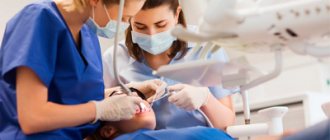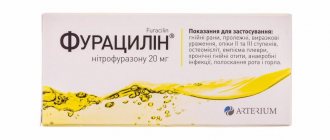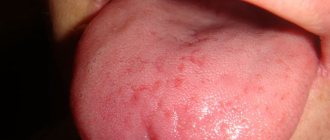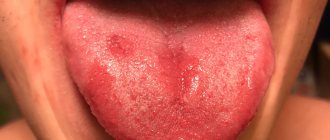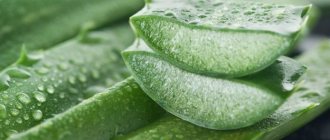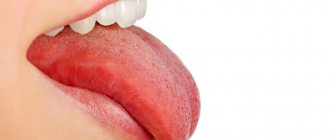What does it represent?
In medical terminology, a pip or callus is called glossitis. This is an inflammatory disease of the tissue fibers of the receptor organ (tongue), caused by the formation of cracks, mechanical damage, wounds or burns on the mucous tissues of the organ where the infection penetrates.
In other words, any cuts on the tongue facilitate the active penetration of bacteria into them, which instantly cause inflammation, redness and create great discomfort.
Glossitis is one of the most common oral pathologies. Children, especially young ones under 5 years of age, are at high risk. They are the ones who pull dirty toys and hands into their mouths, thereby allowing bacteria to penetrate and infect mucous tissues.
How to determine that a denture has a bad effect on the microflora of the oral cavity?
It has been proven that the prosthesis and prosthetic material negatively affect the oral mucosa, as well as numerous elements of its homeostasis.
Dentists consider the subjective complaints of patients to be the main criterion for the influence of a design. Often, denture owners complain of symptoms such as:
- dry mouth;
- continuous burning;
- changes in the usual tastes of foods.
When choosing dentures, the dentist is based on the characteristics of the defects in the dentition and the condition of the remaining teeth. But, unfortunately, doctors very rarely take into account the condition of the mucous membrane itself and its microflora, although they know that the degree of sedimentation of microorganisms on prosthetic materials can vary significantly.
The work of the salivary glands also changes under the influence of dentures:
- the intensity of salivation changes (its sharp decrease is observed);
- the concentration in saliva of total protein, sodium, potassium, as well as biogenic amines decreases;
- lipid peroxidation is activated;
- The protective capabilities of saliva are significantly reduced.
Removable dentures often cause significant dysbiosis in the oral cavity, creating favorable conditions for many pathogenic microorganisms. For example, several years ago scientists discovered such microorganisms under plate structures as:
- enterococcus;
- non-hemolytic streptococcus;
- diplococcus;
- pathogenic staphylococcus;
- gram-positive rods;
- mushrooms of the genus Candida;
- lactobacilli.
As we have already said, most often pathological reproduction of Candida fungi occurs due to a decrease in the body’s immune defense and further colonization of the entire mucous membrane by fungi. While salivation decreases, the number of fungi increases, the microbial balance of the oral cavity changes, which often leads to the development of various types of inflammation of the tissues of the prosthetic bed.
Microorganisms release waste products, and lipid peroxidation processes are activated. Toxic elements increase inflammation and pain reactions and can ultimately cause tissue atrophy.
Causes
As already mentioned, glossitis occurs as a result of damage to the integrity of the soft tissues of the receptor organ. But this is not the only reason.
Quite often, a callus on the tongue does not appear as a separate disease, but indicates the presence of more serious pathologies of the body.
There is a list of factors that, to some extent, can influence the development of glossitis. So, the main causes of calluses on the tongue are as follows:
- Injuries to the mucous tissue and fibers of the tongue. This can be cuts from cutlery, sharp edges of lollipops or sucking sweets, biting the tongue, piercing with a fish bone, damage to the shell from seeds, stale food (bagels, crackers, crispbread, etc.).
- Prolonged sucking of lollipops also leads to damage to the mucous membrane, because such products cause tissue irritation.
- Irritation of the mucous membranes as a result of eating hot, spicy and very salty foods.
- Any allergic reaction to any food can cause swelling of the tongue, which develops into an infectious inflammation.
- Carbonated drinks, concentrated juices, sweet water. All these products contain large amounts of citric acid, which in high concentrations can burn the mucous tissues of the oral cavity. You should be especially careful when drinking alkaline water.
- Drinking alcohol, as alcohol corrodes soft tissue.
- Smoking. Nicotine contained in tobacco consists of 30% heavy salts that burn mucous tissues.
- Very often, the cause of a callus on the tongue can be various types of dental diseases, such as periodontitis, stomatitis or gingivitis.
- Oxidative reactions in the mouth resulting from the installation of braces or plates made of low-quality metals.
- Lack of vitamins, in particular lack of protein and amino acids.
- Acute diseases of the liver, gall bladder, pancreas.
- Poor oral hygiene. Everyone brushes their teeth at least twice a day, but you shouldn’t forget about your tongue. The plaque that accumulates on it indicates that the pores are clogged with food debris.
- Ulcers on the tongue also occur as a concomitant symptom of diseases such as scarlet fever, measles, rubella, and syphilis.
- Infestation caused by worms and other intestinal parasites.
Quite often, small pimples on the tongue can appear during acute respiratory diseases, such as purulent tonsillitis.
It should be remembered that a pip on the tongue is the cause of a condition such as pain, nervousness, and it must be treated regardless of its origin.
Quite often, children develop pimples on their tongues caused by an allergic reaction of the body.
If there is an allergy, the child's tongue becomes covered exclusively with white blisters. This is their main feature. First, you need to exclude foods that could cause allergies from your diet. You will also temporarily have to give up scented soaps, powders and other detergents of synthetic origin. Believe me, regular baby soap or laundry soap will be much more beneficial in this case. Try to wet clean your home and remove dust more often. It is recommended to treat blisters on the tongue of infants with a regular soda solution.
Dear mothers, do not forget that only a qualified specialist can accurately determine the cause of bubbles on the child’s tongue and prescribe the necessary course of treatment.
Do not self-medicate at home, because the most valuable thing is at stake, namely the health of your baby! The main reasons for the formation of bubbles on a child’s tongue
Symptoms
The most important thing is to be able to distinguish ordinary glossitis from inflammation caused by various diseases. At the first signs of pathology, it is recommended to consult a doctor.
Among the main symptoms of calluses on the tongue are:
- changes in the color of the tongue, it can become brighter (rich red or crimson) or, conversely, fade, changing color to white-pink;
- the formation of a large amount of plaque, causing an unpleasant taste and sensation in the mouth;
- small spots that appear in a specific area or throughout the tongue;
- swelling of the tip of the tongue, in which the pores are clearly visible, the surface looks loose;
- tissue compaction, roughening, appearance of small blisters;
- callus can have different shapes - it can be in the form of a purulent abscess, plaque, small tissue compaction, inflammation;
- the tongue may dry out and crack;
- compacted tissues cause discomfort, especially when chewing food, causing sharp pain and burning.
Even the slightest changes in the mucous tissues and fibers of the tongue, which are hardly noticeable to the naked eye, are clearly noticeable, so violations will become known from the very beginning.
How do dentures change the microflora of the oral cavity?
The presence of dentures in the oral cavity, as we have already said, inevitably leads to changes in the quantitative and qualitative composition of the microflora. Here are some examples of the effect of dentures on the microflora of the oral cavity.
- Chromium-nickel metals provoke a decrease in the total number of beneficial bacteria within 14 days after installation of structures.
- Almost any removable denture leads to a doubling of the amount of microflora in the mouth after 6 months.
- With complete removable prosthetics, there is a significant change in the composition of the usual microflora. Fungi of the genus candida, E. coli, sarcina, and actinomycetes appear in large quantities in the mouth. Klebsiella is diagnosed in the mouth, atypical bacteria that provoke the development of many unpleasant diseases. In addition, removable dentures help reduce the amount of lactobacilli in the mouth, and, therefore, reduce the body's resistance to infections.
- When studying denture plaques using microscopes, scientists discovered that this foreign part of the oral cavity consists mainly of bacteria, similar to dental plaques in gingivitis. As a rule, Candida fungi are always sown on dentures in the form of single scattered cells among rod-shaped and filamentous bacteria.
Diagnostics
As mentioned earlier, at the first signs of inflammation of the mucous tissues of the oral cavity, you need to consult a therapist who can determine the severity of the disease and prescribe additional examinations from doctors of a more specialized profile.
As a rule, the diagnosis of glossitis consists of the following steps:
- General examination by a general practitioner.
- Examination of the oral cavity and ENT organs by an otolaryngologist.
- Saliva analysis.
- Analysis of scraping plaque and saliva from the site of inflammation.
- Analysis of pus in the presence of purulent inflammation.
- If necessary, general and extended (biochemistry) blood tests can be performed.
As a rule, all of the above diagnostic methods are quite sufficient to determine the root causes of glossitis formation. A study of saliva and scrapings with pus will help determine the etiology of the disease and determine whether it was caused by a virus or an ordinary infection.
If the problem lies deeper, blood tests will show deviations from the norm in certain indicators, which will become the basis for further, more detailed examination.
Who needs professional oral care?
To all patients. It is important to understand that daily self-brushing of teeth does not allow you to 100% get rid of deposits that are dangerous to oral health. Even properly selected tools and pastes remove approximately 60% of soft plaque.
On the enamel under the gingival margin, on the back side of crowns, and on the side surfaces of teeth, deposits and accumulations of microbes remain, which very quickly turn into tartar. It is impossible to remove these hard deposits on your own, and to maintain the health of your teeth and gums, it is important to regularly seek professional teeth cleaning from your dentist.
Regular professional oral care is especially necessary:
- smokers;
- patients who violate daily oral hygiene;
- patients with pathologies in the structure of the dentition and disorders in chewing food and swallowing;
- patients with braces, dentures and other artificial structures in the mouth.
If tartar begins to be deposited and accumulates in periodontal pockets, the risk of periodontitis and, accordingly, tooth loss will significantly increase. Therefore, each of us needs to undergo regular dental examinations so that the doctor promptly identifies problems in the oral cavity and prescribes cleaning.
Professional teeth cleaning allows you to:
- 100% remove both soft and already hardened plaque from the enamel surface;
- polish the enamel so that plaque accumulates on the teeth more slowly and is easier to remove when brushing;
- remove stains and plaque from the gums, lighten the enamel and restore aesthetics to your smile;
- reduce the risk of caries, bleeding gums, gingivitis, stomatitis and other dental and periodontal diseases;
- strengthen tooth enamel.
It is especially important to regularly have professional teeth and gum cleaning for patients who have a tendency to develop plaque on their enamel, as well as for people predisposed to periodontal disease.
In addition, the presence of tartar is almost always a contraindication to prosthetics, installation of braces and implants. Therefore, dentists often prescribe such a mandatory procedure to patients before starting treatment.
Nutrition
The first step is to remove the load from the tongue so that the disease does not worsen. To do this, use a special diet that limits the consumption of salty, sweet, pepper and spicy foods, and excludes alcohol, carbonated drinks, juices, various sauces, ketchup and mayonnaise from the diet.
Food should be soft, easy to chew, without touching the inflamed areas. This could be mashed potatoes, soy pudding, chicken broth, fruit yoghurts.
If the cause of the callus is an infection, the consumption of fermented milk products is strictly prohibited. The bacteria it contains create a favorable environment for the development of pathogenic organisms, which can aggravate the situation and slow down the treatment process.
What else affects inflammation when wearing dentures?
Firstly, the state of the oral microflora is influenced by the material from which the prosthesis is made. Maximum adhesion of microorganisms is observed when wearing plastic prostheses. When such a structure is in the mouth for a week, 20 new species of bacteria appear in the microflora, many of which are pathogenic.
Secondly, the influence of the prosthesis on the composition of the microflora of the oral cavity is largely determined by the quality of its manufacture and installation.
How to reduce the negative impact of a prosthesis on microflora?
To reduce the negative impact of dentures on the microflora of the oral cavity, it is important for the patient to be as attentive as possible to the daily care of new teeth. For competent and effective daily hygiene you will need:
- preventive toothbrush with a multi-level brush field;
- therapeutic and prophylactic toothpaste of medium or low abrasiveness with mild anti-inflammatory and astringent properties;
- therapeutic and prophylactic rinses with extracts of herbs and plants, anti-caries, antimicrobial, anti-inflammatory, astringent and deodorizing properties;
- flosses for cleaning interdental spaces or any spaces covered with artificial crowns;
- irrigators for massaging gums in “shower” mode and cleaning the rinsing gap.
If chafing occurs while wearing dentures, try using two unique products - ASEPTA FRESH mouth rinse and ASEPTA PARODONTAL gum gel with propolis.
Gel for gums with propolis "ASEPTA®" is made based on the waste product of bees.
- Natural propolis (10%) in the product provides action in 4 directions: antimicrobial, anti-inflammatory, healing, and reduces pain.
- The gel base allows you to apply the product directly to the inflamed area for a targeted effect.
A product for daily oral hygiene, ASEPTA FRESH rinse, has a unique combination of xylitol and potassium citrate, which reduces tooth sensitivity and protects tooth enamel from the negative effects of acids and bacteria. The mouthwash provides comprehensive oral care due to a carefully selected composition of plant extracts and microelements.
The effectiveness and safety of ASEPTA products has been confirmed by numerous clinical studies conducted at the Central Research Institute of Dentistry and Maxillofacial Surgery.
What adorns a person better than any furs and diamonds? Of course, a beautiful healthy smile. But how can you maintain the natural whiteness of your teeth and the health of your gums if every day they are subjected to “tests” in the form of coffee, unhealthy diet, inattentive care and poor ecology? Of course, seek professional oral care. Today we will talk about what this concept hides and what this type of care includes.
Drug treatment
To eliminate pain, discomfort and relieve inflammation, doctors recommend using painkillers, non-steroidal anti-inflammatory drugs, such as Ibuprofen, Ledocaine, Drotaverine.
In case of severe damage, agents are prescribed that accelerate the processes of restoration of mucous tissues. For example, “Glutamine”, “Imudon”.
To eliminate the infection, you must regularly rinse your mouth every 2 hours. For this purpose, special solutions are used - “Furacilin”, “Chlorhexodine”, “Hexoral”.
Contraindications to professional cleaning
Like any health procedure, professional oral care has its contraindications. You should not agree to brush your teeth if you have the following diseases:
- mucosal injuries;
- hepatitis B and C, HIV, AIDS;
- poor blood clotting;
- pathologies of the respiratory system;
- allergy to fluoride-containing drugs;
- any serious diseases of internal organs;
- diseases of teeth and gums in the acute phase.
Folk remedies
If the inflammation is minor, many recommend treating tongue tip at home using both traditional medicine and pharmacy analogues.
The best way to relieve inflammation and disinfect the oral cavity is chamomile infusion. An infusion of oak bark will help heal ulcers and cuts, if any.
In pharmacies you can also buy ready-made concentrates of celandine, calendula, nettle or St. John's wort for rinsing the mouth. It is recommended to lubricate small pustules with sea buckthorn oil or rosehip oil.
What to do if something jumps up and hurts?
Even if we briefly consider all the possible causes of sores on the tongue, it becomes clear that such a seemingly harmless symptom can warn of quite serious health problems. Of course, you should not rush to the doctors even after a minor injury to the tongue (the same seeds), you can completely cope with it on your own. But if an incomprehensible white or red sore suddenly appears on the tongue, and is in no hurry to disappear or decrease within a week, it is better to play it safe and consult a specialist.
How to get rid of the sore?
To successfully get rid of a sore on the tongue at home, you should:
- Remove the load from the organ. It is better to temporarily eliminate the consumption of salty foods, spicy foods, as well as sour, hot and cold foods. Solid foods can also slow down recovery.
- Brush your teeth at least twice a day. At the same time, it is very important not to touch problem areas on the tongue.
- Rinse your mouth with antiseptics after every meal (and every snack). For this purpose, you can use medicinal herbs (for example, sage or chamomile), Miramistin, a solution of Furacilin or Chlorhexidine.
In principle, the measures described will be enough to cope with a simple wound on the tongue that occurs after an injury. But, of course, if there are symptoms of a bacterial or fungal infection, you need to additionally use various specific medications.
Medications
The list of medications used to treat sores on the tongue may differ depending on the cause of such ailment:
- Bacterial lesions require local treatment with antibacterial agents. In case of serious illnesses, internal antibiotics cannot be avoided.
- Fungal diseases are eliminated, accordingly, with antimycotic drugs.
To successfully treat sores on the tongue, drugs that stimulate the activity of the immune system, for example, immunostimulants, including herbal ones, can also be used. Sometimes it makes sense to use multivitamin preparations, medications that improve the composition of beneficial microflora in the intestines, etc. For topical use, medications that can stimulate regenerative processes are sometimes prescribed.
Of course, treatment of sores on the tongue may include the use of symptomatic medications. To eliminate pain and normalize temperature, NSAIDs (ibuprofen, paracetamol, nimesil, etc.) are used, and to reduce swelling and itching, antihistamines (Zyrtec, Cetrin, Erius, Loratadine, etc.) are used.
The treatment regimen for tongue sores is selected individually by a specialist dentist, therapist or pediatrician. You may need the help of other specialized specialists, for example, an infectious disease specialist, dermatologist, oncologist, venereologist or surgeon, depending on the causes of the disease.
How to treat a child?
In young children, the appearance of sores on the tongue is most often associated with the development of candidiasis or stomatitis. For fungal infections of the oral cavity, children are prescribed:
- Regular treatment of the affected areas with a cotton ball soaked in a weak solution of potassium permanganate, 0.25% borax solution or 2% soda solution.
- Lubricating the mucous membranes with a 1-2% solution of aniline dye (for example, methylene blue) or a 0.25% solution of silver nitrate.
- Treatment of mucous membranes with an aqueous suspension of antifungal drugs (Nystatin or Levorin) or a 1% solution of clotrimazole.
- Internal administration of antifungal drugs, for example, fluconazole.
The choice of drugs for the treatment of thrush in childhood is made only by a doctor based on the clinical picture and individual characteristics of the child.
For stomatitis, the treatment regimen for children is different. For kids it is usually recommended:
- Regularly treat the oral cavity with antiseptics, for example, Miramistin, Iodinol, Hexoral or Rotokan.
- Take vitamins and other means to strengthen the immune system.
- Treat the mucous membrane with an oil solution of vitamin A or rosehip oil to speed up the regeneration process.
Of course, successful treatment largely depends on correcting nutrition, eliminating irritants and changing your usual lifestyle. From an early age, children need to be taught the rules of hygiene and oral care.
Preparations for adults
The range of medications used in adult patients is much wider, but the factors that can cause sores on the tongue are an order of magnitude greater. Treatment for this problem directly depends on the cause of its occurrence:
- To eliminate painful sensations, you can use local analgesics - Anestezin tablet powder, Hexoral Tabs lozenges or Lidochlor gel (by the way, it also has antiseptic qualities, since it contains chlorhexidine). Another drug of choice may be Kamistad - a gel with lidocaine and chamomile.
- To suppress the activity of bacteria in the oral cavity, Metrogyl Denta gel can be used. It has antiseptic and antibacterial qualities, has few contraindications for use and perfectly eliminates infection. For internal use, drugs such as amoxicillin, metronidazole, erythromycin, etc. can be used. They are selected individually, focusing on the possible cause of the infection or the sensitivity of the detected bacteria.
- To activate recovery processes, it is most often recommended to use Actovegin or Solcoseryl gel. You can also use the oil medicine Karotolin for this purpose.
If sores on the tongue appear due to serious systemic diseases (tuberculosis, syphilis, HIV infection, etc.), treatment is most often carried out in an inpatient department and is comprehensive. Self-medication in such a situation is dangerous.
Abscess treatment
Sometimes the inflammatory process in the tongue becomes so pronounced that a rather large abscess forms. Most often, such trouble occurs under the tongue or on the side of this organ. And if there is an accumulation of purulent masses, the help of a dental surgeon may be required. The specialist will administer local anesthesia, open the abscess and remove its contents. Also, during surgical treatment, the doctor will conduct a full antiseptic and antibacterial treatment of the affected area.
READ ALSO: Black dots on the nose - causes and methods of elimination. Comedones
After surgery, self-absorbing sutures may be placed on the tongue. The patient is prescribed antibiotic tablets for successful recovery and prevention of complications. Throughout the healing period, you will need to pay special attention to oral hygiene and regularly carry out antiseptic treatment with medications prescribed by your doctor.
Folk remedies
To treat various sores on the tongue, it is quite possible to use alternative medicine. So, this will help solve this problem:
- Chamomile. This plant has good anti-inflammatory and antiseptic qualities. It should be used to prepare an infusion for rinsing. 1 tbsp. l. dry raw materials, brew 1 tbsp. water and leave covered until cool. Strain and use after every meal.
- Calendula. This is another excellent herbal antiseptic with anti-inflammatory qualities. To treat sores on the tongue, you can buy calendula tincture at the pharmacy. 1 tsp. This product should be diluted in 1 tbsp. warm water. Use for rinsing about 4 r. per day.
- Coriander. This is a popular spice that, when used correctly, can effectively relieve inflammation and pain on the tongue. To prepare the medicine you need to brew 1 tbsp. l. coriander 1 tbsp. boiling water and place in a boiling water bath. Let the product sit for 30 minutes, then set it aside from the stove and leave until it cools. Strain it and use it to wipe the affected areas or rinse the mouth (in the latter case, it is advisable to dilute the broth a little with plain water).
- Aloe. This medicinal plant is very easy to use to treat sores on the tongue - you can simply cut the leaf lengthwise and apply the cut to the problem area. You can also grind aloe pulp, combine with honey and use 1 tsp for resorption. several times a day.
- Apple vinegar. To treat sores on the tongue, it is best to use homemade vinegar. Dilute it with water in a 1:1 ratio and use it to rinse your mouth after every meal.
Remember that each of the traditional medicines can cause individual intolerance reactions and other side effects. The advisability of using such medications should be discussed with your doctor.
News MirTesen
Is professional cleaning harmful?
Competent professional oral care is absolutely safe for the health of teeth and gums, provided that the patient has no contraindications for it. You should not clean more than twice a year; more frequent professional care can lead to thinning of the enamel. Microcracks will appear on the teeth, which can cause caries. Frequent cleanings (3-4 times a year) are justified in case of increased saliva viscosity or mineral metabolism disorders.
Another feature of abrasive brushing is the inevitable trauma to the gums. In the presence of dental plaque, the tissues become inflamed to one degree or another and, when exposed to a jet of powder, begin to bleed.
To avoid discomfort after professional teeth cleaning, use Asepta ACTIVE mouth rinse to speed up gum healing. This unique two-component product with a combination of chlorhexidine + benzidamine has an antimicrobial, anti-inflammatory and analgesic effect, providing an instant anesthetic effect to even the most sensitive gums.
- gel for gums
- gel for gums for inflammation
- gel for teeth and gums
- gum treatment gel
- gum strengthening gel
- best gel for gums



